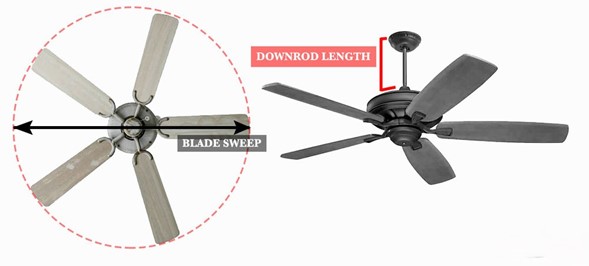A. Conventional Fans vs BLDC fans:
Conventional fans use induction motor whereas BLDC fans use Brushless Direct Current (BLDC) motor. BLDC motors are more energy efficient than induction motors. BLDC fans are electronically controlled and come with a remote control.
B. What is the meaning of sweep size and down rod length?
Sweep size is the diameter of the circle formed by the rotation of the fans. A down rod is an extension pipe made of metal, which is used for hanging the fans from the ceiling. It helps to ensure the stability of the fan and ensures proper air circulation by maintaining a safe distance between the ceiling fan blades and the ceiling.

C. What is meaning of air delivery of fans?
Air delivery refers to the volume of air expelled by a fan per minute. The higher the air delivery value, the greater the airflow generated by the fan. Air delivery is typically measured in cubic meters per minute (CMM)
D. What is the service value in fan?
A fan's service value is determined by the ratio of air delivery in cubic meters per minute to power consumption in watts.
Service value = Air delivery in CMM / Power consumption in watts
A higher service value indicates that the fan is more efficient, as it delivers a greater volume of air while consuming less power
E. What is the service value of a BEE 5 star rated fan?
The service value of a BEE 5 star rated fan should be ≥ 6.0. The service value required for different star ratings of the fans as notified by the BEE is tabulated below:
| Star Levels | Rated Service Value (Cubic meter per minute/Watt) |
|---|---|
| 1 Star* | ≥ 4.0 to < 4.5 |
| 2 Star** | ≥ 4.5 to < 5.0 |
| 3 Star*** | ≥ 5.0 to < 5.5 |
| 4 Star**** | ≥ 5.5 to < 6.0 |
| 5 Star***** | ≥6.0 |
As evident from the table above, the service value varies across star levels, with the minimum value typically found in lower-rated establishments and higher values associated with higher star ratings. For instance, within the 3-star category, the minimum service value is 5.0, while the maximum typically falls below 5.5. It's worth noting that even within the same star level, consumers are advised to seek out establishments offering higher service values.
Example:Fans with a service value of 6.0 and a fan with service value of 7.0 both are 5 stars fans but the fa with service value of 7.0 is more efficient than the one with a service value of 6.0.
F. Is BEE star label mandatory for ceiling fans?
Yes, BEE star label is mandatory for ceiling fans and no ceiling fan in India can be sold without having the BEE star label on it. Ceiling fans come under the mandatory star labelling of BEE.
G. Which material is the ceiling fan winding made up of?
In the market aluminium winding and copper winding fans are available. While both copper and aluminium windings provide the same general functions, copper outranks aluminium when it comes to reliability. Aluminium has only 62% of the electrical conductivity of copper, making copper a much more effective conductor. Aluminium winding fans are generally less expensive but may have a shorter life span. Copper winding fans are more durable.
H. What is RPM in fan?
RPM is revolution per minute or simply speaking it is the rotation speed of a fan. It’s a perception that higher the speed of the fan better the fan is. This is not always true. The important parameter is air delivery or flow i.e. the volume of air fan delivers. With the proper blade design, same amount of air can be delivered with low RPM.
I. How many types of BLDC fans are available?
There are mainly two type of BLDC fans that are available. One is a handheld remote controlled BLDC fan, and another is a wall mounted regulator-controlled BLDC fan.
a. Remote controlled BLDC fans- These type of BLDC fans can be operated through a handheld remote-control unit. Fan ON/OFF and speed regulation can be performed through a remote-control unit. Before installation of such fans, wall regulator already existing in the line must be bypassed. Following are the advantages of remote-control fans:
- i. Best suited for domestic applications
- ii. Provides comfort of controlling the fan with remote control unit
- iii. Wide voltage operability- Fan can run on full speed in the voltage range of 140 Volt to 285 Volt (Brand wise and model wise this voltage range may differ)
b. Wall mounted regulator BLDC fans- These type of BLDC fans are compatible with a wall mounted regulator. Fan ON/OFF, speed regulation can be performed through wall mounted regulator. Following are the advantages of remote-control fans:
- i. Best suited for commercial establishments such as school, college, office applications
- ii. No need to bypass the existing regulator
J. If the upfront cost of BLDC fans is higher than conventional ones, then why should I buy the them?
The upfront cost of the BLDC fans may look higher than conventional fans but the differential cost you may pay over the price of conventional fan can be recovered within 1.5 years (tentative). The total ownership cost of BLDC fans will be less than the total ownership cost of conventional fans. Example given below may be referred to:
| SL No | Description | Column A | Column B (18% GST) | Remarks/Assumptions |
|---|---|---|---|---|
| Conventional 75 Watt Fan | BEE 5 Star Fan | |||
| 1 | Wattage | 75 | 30 | |
| 2 | Hourly consumption (KWh) | 0.075 | 0.03 | |
| 3 | Daily Consumption (KWh) | 0.9 | 0.36 | Assuming 12 hrs of usage |
| 4 | Yearly Consumption (KWh) | 270 | 108 | Assuming 300 days per year operation |
| 5 | Per unit electricity cost INR per unit | 6 | 6 | Assuming the rate of electricity as INR 6 per unit |
| 6 | Yearly Electricity consumption in INR | 1620 | 648 | Saving INR 1620-INR 756 |
| 7 | Electricity consumption in 3 years INR | 4860 | 1944 | |
| 8 | One time Fan Procurement cost INR | 1500 | 3000 | |
| 9 | Total Ownership cost at the end of 3rd year INR | 6360 | 4944 | 1416 |
| 10 | Payback Period for the differential cost (Years) | 1.54 | Simple Payback Period |
-05.png)



